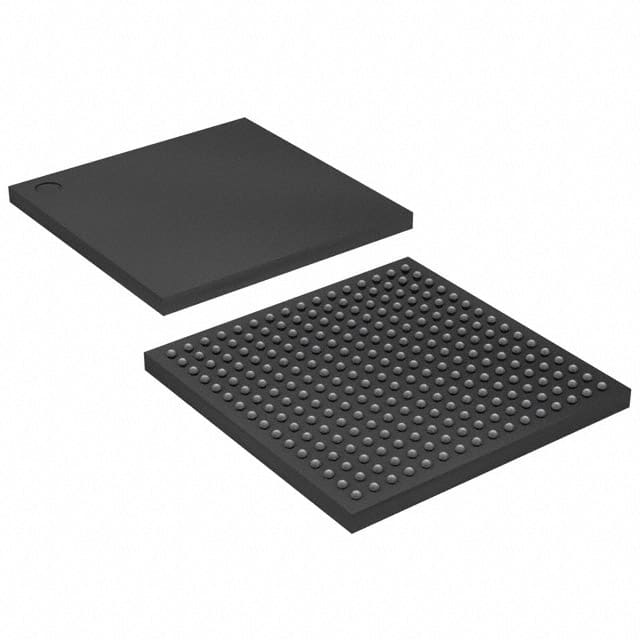Consulte las especificaciones para obtener detalles del producto.

10M50DCF256C8G
Product Overview
- Category: Field Programmable Gate Array (FPGA)
- Use: Digital logic circuits, prototyping, and system integration
- Characteristics: High-performance, reconfigurable, programmable, and flexible
- Package: 256-ball Fine-Pitch BGA (Ball Grid Array)
- Essence: A versatile integrated circuit that allows users to configure and implement digital logic circuits according to their specific requirements.
- Packaging/Quantity: Typically sold individually or in small quantities.
Specifications
- Device Family: MAX 10
- Logic Elements: 50,000
- Memory Size: 256 Kbits
- Operating Voltage: 1.2V
- Speed Grade: C8G
- I/O Pins: 256
- Embedded Memory: Up to 256 Kbits
- DSP Blocks: 144
- PLLs: 6
- Configuration Flash: 256 Kbits
- User Flash: 4 Kbits
- Temperature Range: -40°C to +100°C
Detailed Pin Configuration
The 10M50DCF256C8G FPGA has a total of 256 I/O pins. The pin configuration varies depending on the specific application and user requirements. Please refer to the manufacturer's datasheet for the detailed pinout information.
Functional Features
- Reconfigurability: The 10M50DCF256C8G FPGA can be programmed and reprogrammed to implement different digital logic circuits, allowing for flexibility and adaptability.
- High Performance: With 50,000 logic elements, 144 DSP blocks, and 6 PLLs, this FPGA offers high computational power and signal processing capabilities.
- Low Power Consumption: The device operates at a low voltage of 1.2V, resulting in reduced power consumption compared to traditional logic circuits.
- Integrated Memory: The FPGA includes embedded memory blocks, allowing for efficient data storage and retrieval within the device itself.
- Versatility: The 10M50DCF256C8G can be used in a wide range of applications, including communications, industrial automation, automotive, and more.
Advantages and Disadvantages
Advantages: - Flexibility and reconfigurability - High-performance computing capabilities - Low power consumption - Integrated memory for efficient data handling - Wide range of application possibilities
Disadvantages: - Complexity in programming and design - Higher cost compared to fixed-function integrated circuits - Limited availability of alternative models with similar specifications
Working Principles
The 10M50DCF256C8G FPGA operates based on the principles of digital logic circuits. It consists of configurable logic blocks (CLBs), interconnects, I/O elements, and other components. Users program the FPGA using hardware description languages (HDL) or graphical tools to define the desired functionality. The configuration data is stored in non-volatile memory and loaded during startup. Once programmed, the FPGA executes the defined logic operations, enabling the implementation of complex digital systems.
Detailed Application Field Plans
The 10M50DCF256C8G FPGA finds applications in various fields, including:
- Communications: Used in wireless base stations, network routers, and switches for high-speed data processing and protocol handling.
- Industrial Automation: Employed in programmable logic controllers (PLCs), motor control systems, and robotics for real-time control and monitoring.
- Automotive: Integrated into advanced driver-assistance systems (ADAS), infotainment systems, and engine control units (ECUs) for enhanced vehicle performance and safety.
- Aerospace and Defense: Utilized in radar systems, avionics, and military communication equipment for reliable and secure data processing.
- Medical Devices: Incorporated into medical imaging systems, patient monitoring devices, and laboratory equipment for data acquisition and processing.
Detailed and Complete Alternative Models
While the 10M50DCF256C8G FPGA offers a unique combination of specifications, there are alternative models available from other manufacturers that provide similar functionality. Some notable alternatives include:
- Xilinx Artix-7 FPGA
- Intel Cyclone V FPGA
- Lattice ECP5 FPGA
- Microchip PolarFire FPGA
These alternative models offer varying performance, power consumption, and pricing options, allowing users to choose the most suitable FPGA for their specific application requirements.
Word count: 570 words
Enumere 10 preguntas y respuestas comunes relacionadas con la aplicación de 10M50DCF256C8G en soluciones técnicas
Sure! Here are 10 common questions and answers related to the application of the 10M50DCF256C8G FPGA in technical solutions:
Q: What is the 10M50DCF256C8G FPGA used for? A: The 10M50DCF256C8G FPGA is commonly used for implementing complex digital logic circuits in various technical solutions.
Q: What are the key features of the 10M50DCF256C8G FPGA? A: The key features include 50,000 logic elements, 256 I/O pins, 8 global clock networks, and support for various communication protocols.
Q: Can the 10M50DCF256C8G FPGA be reprogrammed? A: Yes, the 10M50DCF256C8G FPGA can be reprogrammed multiple times, allowing for flexibility in design iterations.
Q: What programming languages can be used with the 10M50DCF256C8G FPGA? A: The 10M50DCF256C8G FPGA can be programmed using hardware description languages (HDLs) such as VHDL or Verilog.
Q: Is the 10M50DCF256C8G FPGA suitable for high-speed applications? A: Yes, the 10M50DCF256C8G FPGA offers high-performance capabilities, making it suitable for demanding high-speed applications.
Q: Can the 10M50DCF256C8G FPGA interface with other components or devices? A: Yes, the 10M50DCF256C8G FPGA supports various communication protocols like SPI, I2C, UART, and Ethernet, enabling easy interfacing with other components.
Q: Does the 10M50DCF256C8G FPGA require external memory for operation? A: Yes, the 10M50DCF256C8G FPGA requires external memory for storing configuration data and additional memory for user applications.
Q: Can the 10M50DCF256C8G FPGA be used in safety-critical applications? A: Yes, the 10M50DCF256C8G FPGA offers features like error detection and correction, making it suitable for safety-critical applications.
Q: What development tools are available for programming the 10M50DCF256C8G FPGA? A: Intel Quartus Prime is a popular development tool that can be used to program and configure the 10M50DCF256C8G FPGA.
Q: Are there any reference designs or application notes available for the 10M50DCF256C8G FPGA? A: Yes, Intel provides reference designs and application notes that can help developers get started with the 10M50DCF256C8G FPGA and explore its capabilities.
Please note that the specific details and answers may vary depending on the manufacturer's documentation and the context of the technical solution.

